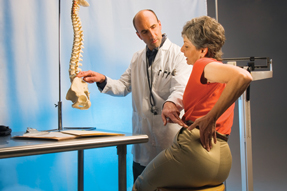Reclaiming who we are: Internal medicine's central role
Internists must use their admirable heritage to provide the best care for patients and reclaim internal medicine's central role in delivering health care.
From the outside, the American College of Physicians is an organization with a mission: “To enhance the quality and effectiveness of health care by fostering excellence and professionalism in the practice of medicine.” It also has a reputation for thoughtful, considered advocacy positions based on carefully researched and crafted policy for the benefit of our patients and the community.
From the inside, ACP is the members who make up the chapters, councils and committees, and the staff, all of whom work together to develop the policies, programs, products and services on which all our activities are based. We are a diverse group of 130,000 Masters, Fellows, Members, Associates, medical students and affiliates. We practice within and outside hospitals, in solo practice or in groups of two to more than 30. Some are self-employed but more, if the current trends continue, are employed by organizations. We are a global community, with 13 of our 81 chapters outside the U.S. and with members in 128 countries.
The focus of our practices is also increasingly varied. Some of us concentrate our clinical efforts on organ disorders or disease processes, others on severity of illness, and yet others on systems of health care delivery. These evolving practice patterns have led us to attach a variety of “-ists” to our subgroup identities, providing opportunities for targeted education, research and collegiality.
But that is not who we are. Despite Osler's claim that “The student of internal medicine cannot be a specialist,” we are all specialists in internal medicine knowledge and practice. We have all come from the same great tradition of pathophysiology. How we use our admirable heritage and how we respond to the current challenges to provide the best care for our patients are the most important factors that define who we are and will determine where we must go to strengthen and sustain our future.
The term innere medizin was first documented in 1882 in the transactions of the Congress of Internal Medicine in Wiesbaden, Germany. It was coined to distinguish between treating clinical symptoms and organ-based disease. The internist was a specialist physician who strove to understand the basis of disease. The brilliance of the historically great physicians (Osler, Harrison, Cecil and many others), manifested in their understanding and skillful use of the pathophysiological approach to the management of complex medical disease, has long captivated us and piqued our curiosity.
In their wake, our mentors, who appeared to be the smartest and most caring physicians, continued to inspire us to emulate them. We valued this great tradition where physicians were supreme, solving all medical problems through the intuitive approach of experimentation and pattern recognition, and we believed it was the pinnacle of medical practice.
However, nostalgia must be tempered by reality. Not too long ago the information paradigm was expert opinion and diffusion of innovation. The practice paradigm was physician-centric and authoritarian. Patients expected care without their input or responsibility. Systems were limited to hospitals. Health care teams existed only in a few subspecialty disciplines. Although we thought we were providing quality care, we didn't measure it well or at all, and cost as a factor was rarely considered and even disdained.
We are now living in times when advances in medicine have never been more exciting, and the pace is exponential. The promise of gene therapy to cure disease seems less like a dream when you hear that new organs are being grown on biological scaffolding. There are more and better diagnostic tools and devices as well as pharmaceutical and biologic medications than was conceivable even 10 years ago, and information is readily available to all due to the e-revolution.
Our patients deserve the best treatments, but they also deserve value. We are now faced not only with how to provide them with high-value care but also with how to enable them to participate in the decisions about their care. To do this we must build on our inheritance of an expanding body of knowledge based on even more complex pathophysiology.
We must also be proud of our synthetic and analytic skills, applying them both to diagnosis and to clinical decision making. We must use diagnostic and therapeutic strategies that have real value because they are proven to increase quality, reduce overall cost and avoid harm. We must explain risk and benefit to patients, clinicians, politicians and payers. We must advocate for systems of care that reinforce trust between physicians and patients by engaging them in shared responsibility, providing continuity and coordination of care and adequate time to talk and be heard, which they so desperately want. And, painful as it may be for some, we must adopt payment systems that reward value, not volume.
The patient-centered medical home and neighborhood, endorsed and promoted by the College, is a system that can help to rebuild trust while providing comprehensive, continuous and coordinated care. It too must be evaluated and improved. The high-value cost-conscious care initiative launched in February in the Annals of Internal Medicine is one we can all embrace. It does not depend on our own particular “-ist,” just on the realization that we are the ones who order the tests, prescribe the medications, and are ultimately responsible for promoting the high-value cost-conscious care our patients deserve.
These and other efforts to develop better systems of care will involve building partnerships with patients, caregivers, all health care professionals, payers and each other. We must come out of our comfortable silos and “-ist” identities to reclaim leadership in health care reform in a time of shrinking resources. We must do this together so as to provide the best care to an increasing number of patients while addressing costs, quality and disparities. These are challenges indeed, but that is who we are—specialist physicians who take on challenges for the well-being of our patients and the community. I trust that you will join me and the College in these efforts to ensure internal medicine's patient-centered bright future.




